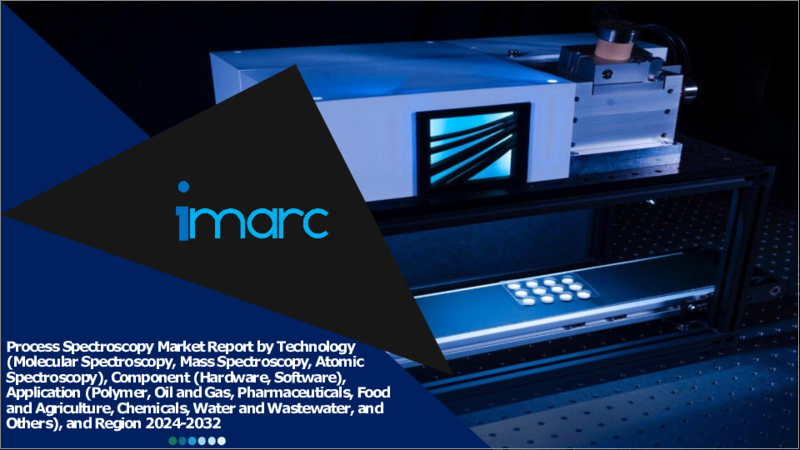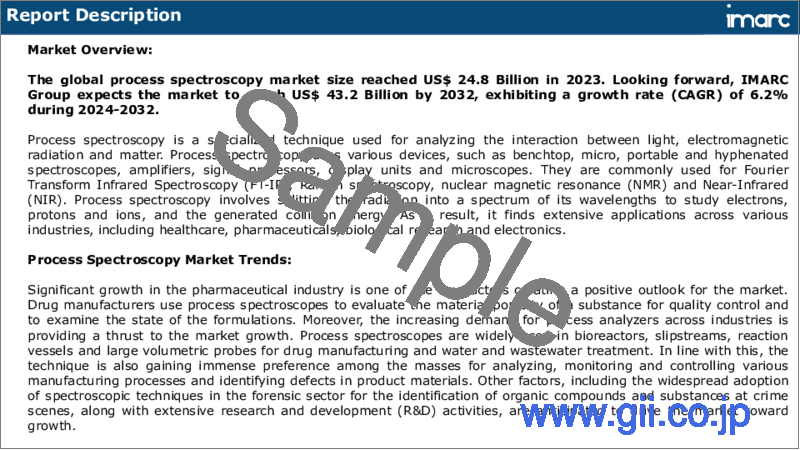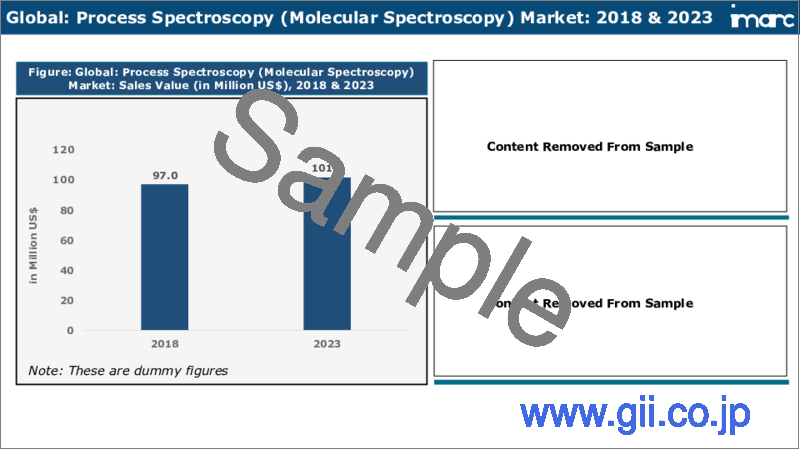|
|
市場調査レポート
商品コード
1541366
プロセス分光法の市場レポート:技術、コンポーネント、用途、地域別、2024~2032年Process Spectroscopy Market Report by Technology, Component, Application, and Region 2024-2032 |
||||||
カスタマイズ可能
|
|||||||
| プロセス分光法の市場レポート:技術、コンポーネント、用途、地域別、2024~2032年 |
|
出版日: 2024年08月10日
発行: IMARC
ページ情報: 英文 137 Pages
納期: 2~3営業日
|
- 全表示
- 概要
- 図表
- 目次
世界のプロセス分光法の市場規模は2023年に248億米ドルに達しました。今後、IMARC Groupは、市場は2032年までに432億米ドルに達し、2024~2032年の間に6.2%の成長率(CAGR)を示すと予測しています。
プロセス分光法は、光、電磁波、物質間の相互作用を分析するために使用される専門技術です。プロセス分光法では、ベンチトップ、マイクロ、ポータブル、ハイフン分光器、アンプ、シグナルプロセッサ、ディスプレイユニット、顕微鏡など様々なデバイスを使用します。これらは一般的にフーリエ変換赤外分光法(FT-IR)、ラマン分光法、核磁気共鳴法(NMR)、近赤外分光法(NIR)に使用されます。プロセス分光法では、電子、陽子、イオン、生成された衝突エネルギーを研究するために、放射線を波長スペクトルに分割します。その結果、医療、製薬、生物学的研究、エレクトロニクスなど、さまざまな業界で幅広く応用されています。
プロセス分光法の市場動向
製薬業界の著しい成長は、市場の明るい展望を生み出す重要な要因の一つです。医薬品メーカーは、品質管理のために物質の多孔性を評価し、製剤の状態を調べるためにプロセス分光器を使用しています。さらに、産業界全体でプロセスアナライザーの需要が増加していることが、市場成長の推進力となっています。治療用分光器は、バイオリアクター、スリップストリーム、反応容器、医薬品製造や水・廃水処理用の大容量プローブなどで広く使用されています。これに伴い、この技術は、様々な製造プロセスの分析、監視、制御、製品材料の欠陥の特定など、大衆の間で絶大な支持を得ています。その他の要因としては、犯罪現場での有機化合物や物質の同定のために法医学セグメントで分光技術が広く採用されていることや、広範な研究開発(R&D)活動などがあり、市場の成長に向けた原動力になると予測されています。
本レポートで扱う主要質問
- プロセス分光法の市場の世界市場はこれまでどのように推移し、今後どのように推移していくのか?
- COVID-19は世界のプロセス分光法の市場にどのような影響を与えたか?
- 主要地域市場とは?
- 技術別の市場内訳は?
- コンポーネント別の市場内訳は?
- 用途別の市場内訳は?
- 業界のバリューチェーンにおける様々な段階とは?
- 業界の主要な促進要因と課題は何か?
- 世界のプロセス分光法の市場の構造と主要参入企業は?
- 業界の競合の程度は?
目次
第1章 序文
第2章 調査範囲と調査手法
- 調査の目的
- ステークホルダー
- データソース
- 一次情報
- 二次情報
- 市場推定
- ボトムアップアプローチ
- トップダウンアプローチ
- 調査手法
第3章 エグゼクティブサマリー
第4章 イントロダクション
- 概要
- 主要業界動向
第5章 世界のプロセス分光法市場
- 市場概要
- 市場実績
- COVID-19の影響
- 市場予測
第6章 市場内訳:技術別
- 分子分光法
- 質量分析法
- 原子分光法
第7章 市場内訳:コンポーネント別
- ハードウェア
- ソフトウェア
第8章 市場内訳:用途別
- ポリマー
- 石油・ガス
- 医薬品
- 食料と農業
- 化学品
- 水と廃水
- その他
第9章 市場内訳:地域別
- 北米
- 米国
- カナダ
- アジア太平洋
- 中国
- 日本
- インド
- 韓国
- オーストラリア
- インドネシア
- その他
- 欧州
- ドイツ
- フランス
- 英国
- イタリア
- スペイン
- ロシア
- その他
- ラテンアメリカ
- ブラジル
- メキシコ
- その他
- 中東・アフリカ
- 市場動向
- 市場内訳:国別
- 市場予測
第10章 SWOT分析
- 概要
- 強み
- 弱み
- 機会
- 脅威
第11章 バリューチェーン分析
第12章 ポーターのファイブフォース分析
- 概要
- 買い手の交渉力
- 供給企業の交渉力
- 競合の程度
- 新規参入業者の脅威
- 代替品の脅威
第13章 価格分析
第14章 競合情勢
- 市場構造
- 主要企業
- 主要企業のプロファイル
- ABB Ltd
- Agilent Technologies Inc.
- Bruker Corporation
- Buchi Labortechnik AG
- Danaher Corporation
- Foss A/S
- Horiba Ltd.
- Kett Electric Laboratory
- Sartorius AG
- Shimadzu Corporation
- Thermo Fisher Scientific Inc.
- Yokogawa Electric Corporation
List of Figures
- Figure 1: Global: Process Spectroscopy Market: Major Drivers and Challenges
- Figure 2: Global: Process Spectroscopy Market: Sales Value (in Billion US$), 2018-2023
- Figure 3: Global: Process Spectroscopy Market Forecast: Sales Value (in Billion US$), 2024-2032
- Figure 4: Global: Process Spectroscopy Market: Breakup by Technology (in %), 2023
- Figure 5: Global: Process Spectroscopy Market: Breakup by Component (in %), 2023
- Figure 6: Global: Process Spectroscopy Market: Breakup by Application (in %), 2023
- Figure 7: Global: Process Spectroscopy Market: Breakup by Region (in %), 2023
- Figure 8: Global: Process Spectroscopy (Molecular Spectroscopy) Market: Sales Value (in Million US$), 2018 & 2023
- Figure 9: Global: Process Spectroscopy (Molecular Spectroscopy) Market Forecast: Sales Value (in Million US$), 2024-2032
- Figure 10: Global: Process Spectroscopy (Mass Spectroscopy) Market: Sales Value (in Million US$), 2018 & 2023
- Figure 11: Global: Process Spectroscopy (Mass Spectroscopy) Market Forecast: Sales Value (in Million US$), 2024-2032
- Figure 12: Global: Process Spectroscopy (Atomic Spectroscopy) Market: Sales Value (in Million US$), 2018 & 2023
- Figure 13: Global: Process Spectroscopy (Atomic Spectroscopy) Market Forecast: Sales Value (in Million US$), 2024-2032
- Figure 14: Global: Process Spectroscopy (Hardware) Market: Sales Value (in Million US$), 2018 & 2023
- Figure 15: Global: Process Spectroscopy (Hardware) Market Forecast: Sales Value (in Million US$), 2024-2032
- Figure 16: Global: Process Spectroscopy (Software) Market: Sales Value (in Million US$), 2018 & 2023
- Figure 17: Global: Process Spectroscopy (Software) Market Forecast: Sales Value (in Million US$), 2024-2032
- Figure 18: Global: Process Spectroscopy (Polymer) Market: Sales Value (in Million US$), 2018 & 2023
- Figure 19: Global: Process Spectroscopy (Polymer) Market Forecast: Sales Value (in Million US$), 2024-2032
- Figure 20: Global: Process Spectroscopy (Oil and Gas) Market: Sales Value (in Million US$), 2018 & 2023
- Figure 21: Global: Process Spectroscopy (Oil and Gas) Market Forecast: Sales Value (in Million US$), 2024-2032
- Figure 22: Global: Process Spectroscopy (Pharmaceuticals) Market: Sales Value (in Million US$), 2018 & 2023
- Figure 23: Global: Process Spectroscopy (Pharmaceuticals) Market Forecast: Sales Value (in Million US$), 2024-2032
- Figure 24: Global: Process Spectroscopy (Food and Agriculture) Market: Sales Value (in Million US$), 2018 & 2023
- Figure 25: Global: Process Spectroscopy (Food and Agriculture) Market Forecast: Sales Value (in Million US$), 2024-2032
- Figure 26: Global: Process Spectroscopy (Chemicals) Market: Sales Value (in Million US$), 2018 & 2023
- Figure 27: Global: Process Spectroscopy (Chemicals) Market Forecast: Sales Value (in Million US$), 2024-2032
- Figure 28: Global: Process Spectroscopy (Water and Wastewater) Market: Sales Value (in Million US$), 2018 & 2023
- Figure 29: Global: Process Spectroscopy (Water and Wastewater) Market Forecast: Sales Value (in Million US$), 2024-2032
- Figure 30: Global: Process Spectroscopy (Other Applications) Market: Sales Value (in Million US$), 2018 & 2023
- Figure 31: Global: Process Spectroscopy (Other Applications) Market Forecast: Sales Value (in Million US$), 2024-2032
- Figure 32: North America: Process Spectroscopy Market: Sales Value (in Million US$), 2018 & 2023
- Figure 33: North America: Process Spectroscopy Market Forecast: Sales Value (in Million US$), 2024-2032
- Figure 34: United States: Process Spectroscopy Market: Sales Value (in Million US$), 2018 & 2023
- Figure 35: United States: Process Spectroscopy Market Forecast: Sales Value (in Million US$), 2024-2032
- Figure 36: Canada: Process Spectroscopy Market: Sales Value (in Million US$), 2018 & 2023
- Figure 37: Canada: Process Spectroscopy Market Forecast: Sales Value (in Million US$), 2024-2032
- Figure 38: Asia-Pacific: Process Spectroscopy Market: Sales Value (in Million US$), 2018 & 2023
- Figure 39: Asia-Pacific: Process Spectroscopy Market Forecast: Sales Value (in Million US$), 2024-2032
- Figure 40: China: Process Spectroscopy Market: Sales Value (in Million US$), 2018 & 2023
- Figure 41: China: Process Spectroscopy Market Forecast: Sales Value (in Million US$), 2024-2032
- Figure 42: Japan: Process Spectroscopy Market: Sales Value (in Million US$), 2018 & 2023
- Figure 43: Japan: Process Spectroscopy Market Forecast: Sales Value (in Million US$), 2024-2032
- Figure 44: India: Process Spectroscopy Market: Sales Value (in Million US$), 2018 & 2023
- Figure 45: India: Process Spectroscopy Market Forecast: Sales Value (in Million US$), 2024-2032
- Figure 46: South Korea: Process Spectroscopy Market: Sales Value (in Million US$), 2018 & 2023
- Figure 47: South Korea: Process Spectroscopy Market Forecast: Sales Value (in Million US$), 2024-2032
- Figure 48: Australia: Process Spectroscopy Market: Sales Value (in Million US$), 2018 & 2023
- Figure 49: Australia: Process Spectroscopy Market Forecast: Sales Value (in Million US$), 2024-2032
- Figure 50: Indonesia: Process Spectroscopy Market: Sales Value (in Million US$), 2018 & 2023
- Figure 51: Indonesia: Process Spectroscopy Market Forecast: Sales Value (in Million US$), 2024-2032
- Figure 52: Others: Process Spectroscopy Market: Sales Value (in Million US$), 2018 & 2023
- Figure 53: Others: Process Spectroscopy Market Forecast: Sales Value (in Million US$), 2024-2032
- Figure 54: Europe: Process Spectroscopy Market: Sales Value (in Million US$), 2018 & 2023
- Figure 55: Europe: Process Spectroscopy Market Forecast: Sales Value (in Million US$), 2024-2032
- Figure 56: Germany: Process Spectroscopy Market: Sales Value (in Million US$), 2018 & 2023
- Figure 57: Germany: Process Spectroscopy Market Forecast: Sales Value (in Million US$), 2024-2032
- Figure 58: France: Process Spectroscopy Market: Sales Value (in Million US$), 2018 & 2023
- Figure 59: France: Process Spectroscopy Market Forecast: Sales Value (in Million US$), 2024-2032
- Figure 60: United Kingdom: Process Spectroscopy Market: Sales Value (in Million US$), 2018 & 2023
- Figure 61: United Kingdom: Process Spectroscopy Market Forecast: Sales Value (in Million US$), 2024-2032
- Figure 62: Italy: Process Spectroscopy Market: Sales Value (in Million US$), 2018 & 2023
- Figure 63: Italy: Process Spectroscopy Market Forecast: Sales Value (in Million US$), 2024-2032
- Figure 64: Spain: Process Spectroscopy Market: Sales Value (in Million US$), 2018 & 2023
- Figure 65: Spain: Process Spectroscopy Market Forecast: Sales Value (in Million US$), 2024-2032
- Figure 66: Russia: Process Spectroscopy Market: Sales Value (in Million US$), 2018 & 2023
- Figure 67: Russia: Process Spectroscopy Market Forecast: Sales Value (in Million US$), 2024-2032
- Figure 68: Others: Process Spectroscopy Market: Sales Value (in Million US$), 2018 & 2023
- Figure 69: Others: Process Spectroscopy Market Forecast: Sales Value (in Million US$), 2024-2032
- Figure 70: Latin America: Process Spectroscopy Market: Sales Value (in Million US$), 2018 & 2023
- Figure 71: Latin America: Process Spectroscopy Market Forecast: Sales Value (in Million US$), 2024-2032
- Figure 72: Brazil: Process Spectroscopy Market: Sales Value (in Million US$), 2018 & 2023
- Figure 73: Brazil: Process Spectroscopy Market Forecast: Sales Value (in Million US$), 2024-2032
- Figure 74: Mexico: Process Spectroscopy Market: Sales Value (in Million US$), 2018 & 2023
- Figure 75: Mexico: Process Spectroscopy Market Forecast: Sales Value (in Million US$), 2024-2032
- Figure 76: Others: Process Spectroscopy Market: Sales Value (in Million US$), 2018 & 2023
- Figure 77: Others: Process Spectroscopy Market Forecast: Sales Value (in Million US$), 2024-2032
- Figure 78: Middle East and Africa: Process Spectroscopy Market: Sales Value (in Million US$), 2018 & 2023
- Figure 79: Middle East and Africa: Process Spectroscopy Market: Breakup by Country (in %), 2023
- Figure 80: Middle East and Africa: Process Spectroscopy Market Forecast: Sales Value (in Million US$), 2024-2032
- Figure 81: Global: Process Spectroscopy Industry: SWOT Analysis
- Figure 82: Global: Process Spectroscopy Industry: Value Chain Analysis
- Figure 83: Global: Process Spectroscopy Industry: Porter's Five Forces Analysis
List of Tables
- Table 1: Global: Process Spectroscopy Market: Key Industry Highlights, 2023 and 2032
- Table 2: Global: Process Spectroscopy Market Forecast: Breakup by Technology (in Million US$), 2024-2032
- Table 3: Global: Process Spectroscopy Market Forecast: Breakup by Component (in Million US$), 2024-2032
- Table 4: Global: Process Spectroscopy Market Forecast: Breakup by Application (in Million US$), 2024-2032
- Table 5: Global: Process Spectroscopy Market Forecast: Breakup by Region (in Million US$), 2024-2032
- Table 6: Global: Process Spectroscopy Market: Competitive Structure
- Table 7: Global: Process Spectroscopy Market: Key Players
The global process spectroscopy market size reached US$ 24.8 Billion in 2023. Looking forward, IMARC Group expects the market to reach US$ 43.2 Billion by 2032, exhibiting a growth rate (CAGR) of 6.2% during 2024-2032.
Process spectroscopy is a specialized technique used for analyzing the interaction between light, electromagnetic radiation and matter. Process spectroscopy uses various devices, such as benchtop, micro, portable and hyphenated spectroscopes, amplifiers, signal processors, display units and microscopes. They are commonly used for Fourier Transform Infrared Spectroscopy (FT-IR), Raman spectroscopy, nuclear magnetic resonance (NMR) and Near-Infrared (NIR). Process spectroscopy involves splitting the radiation into a spectrum of its wavelengths to study electrons, protons and ions, and the generated collision energy. As a result, it finds extensive applications across various industries, including healthcare, pharmaceuticals, biological research and electronics.
Process Spectroscopy Market Trends:
Significant growth in the pharmaceutical industry is one of the key factors creating a positive outlook for the market. Drug manufacturers use process spectroscopes to evaluate the material porosity of a substance for quality control and to examine the state of the formulations. Moreover, the increasing demand for process analyzers across industries is providing a thrust to the market growth. Process spectroscopes are widely used in bioreactors, slipstreams, reaction vessels and large volumetric probes for drug manufacturing and water and wastewater treatment. In line with this, the technique is also gaining immense preference among the masses for analyzing, monitoring and controlling various manufacturing processes and identifying defects in product materials. Other factors, including the widespread adoption of spectroscopic techniques in the forensic sector for the identification of organic compounds and substances at crime scenes, along with extensive research and development (R&D) activities, are anticipated to drive the market toward growth.
Key Market Segmentation:
IMARC Group provides an analysis of the key trends in each sub-segment of the global process spectroscopy market report, along with forecasts at the global, regional and country level from 2024-2032. Our report has categorized the market based on technology, component and application.
Breakup by Technology:
Molecular Spectroscopy
Mass Spectroscopy
Atomic Spectroscopy
Breakup by Component:
Hardware
Software
Breakup by Application:
Polymer
Oil and Gas
Pharmaceuticals
Food and Agriculture
Chemicals
Water and Wastewater
Others
Breakup by Region:
North America
United States
Canada
Asia-Pacific
China
Japan
India
South Korea
Australia
Indonesia
Others
Europe
Germany
France
United Kingdom
Italy
Spain
Russia
Others
Latin America
Brazil
Mexico
Others
Middle East and Africa
Competitive Landscape:
The competitive landscape of the industry has also been examined along with the profiles of the key players being ABB Ltd, Agilent Technologies Inc., Bruker Corporation, Buchi Labortechnik AG, Danaher Corporation, Foss A/S, Horiba Ltd., Kett Electric Laboratory, Sartorius AG, Shimadzu Corporation, Thermo Fisher Scientific Inc. and Yokogawa Electric Corporation.
Key Questions Answered in This Report:
- How has the global process spectroscopy market performed so far and how will it perform in the coming years?
- What has been the impact of COVID-19 on the global process spectroscopy market?
- What are the key regional markets?
- What is the breakup of the market based on the technology?
- What is the breakup of the market based on the component?
- What is the breakup of the market based on the application?
- What are the various stages in the value chain of the industry?
- What are the key driving factors and challenges in the industry?
- What is the structure of the global process spectroscopy market and who are the key players?
- What is the degree of competition in the industry?
Table of Contents
1 Preface
2 Scope and Methodology
- 2.1 Objectives of the Study
- 2.2 Stakeholders
- 2.3 Data Sources
- 2.3.1 Primary Sources
- 2.3.2 Secondary Sources
- 2.4 Market Estimation
- 2.4.1 Bottom-Up Approach
- 2.4.2 Top-Down Approach
- 2.5 Forecasting Methodology
3 Executive Summary
4 Introduction
- 4.1 Overview
- 4.2 Key Industry Trends
5 Global Process Spectroscopy Market
- 5.1 Market Overview
- 5.2 Market Performance
- 5.3 Impact of COVID-19
- 5.4 Market Forecast
6 Market Breakup by Technology
- 6.1 Molecular Spectroscopy
- 6.1.1 Market Trends
- 6.1.2 Market Forecast
- 6.2 Mass Spectroscopy
- 6.2.1 Market Trends
- 6.2.2 Market Forecast
- 6.3 Atomic Spectroscopy
- 6.3.1 Market Trends
- 6.3.2 Market Forecast
7 Market Breakup by Component
- 7.1 Hardware
- 7.1.1 Market Trends
- 7.1.2 Market Forecast
- 7.2 Software
- 7.2.1 Market Trends
- 7.2.2 Market Forecast
8 Market Breakup by Application
- 8.1 Polymer
- 8.1.1 Market Trends
- 8.1.2 Market Forecast
- 8.2 Oil and Gas
- 8.2.1 Market Trends
- 8.2.2 Market Forecast
- 8.3 Pharmaceuticals
- 8.3.1 Market Trends
- 8.3.2 Market Forecast
- 8.4 Food and Agriculture
- 8.4.1 Market Trends
- 8.4.2 Market Forecast
- 8.5 Chemicals
- 8.5.1 Market Trends
- 8.5.2 Market Forecast
- 8.6 Water and Wastewater
- 8.6.1 Market Trends
- 8.6.2 Market Forecast
- 8.7 Others
- 8.7.1 Market Trends
- 8.7.2 Market Forecast
9 Market Breakup by Region
- 9.1 North America
- 9.1.1 United States
- 9.1.1.1 Market Trends
- 9.1.1.2 Market Forecast
- 9.1.2 Canada
- 9.1.2.1 Market Trends
- 9.1.2.2 Market Forecast
- 9.1.1 United States
- 9.2 Asia-Pacific
- 9.2.1 China
- 9.2.1.1 Market Trends
- 9.2.1.2 Market Forecast
- 9.2.2 Japan
- 9.2.2.1 Market Trends
- 9.2.2.2 Market Forecast
- 9.2.3 India
- 9.2.3.1 Market Trends
- 9.2.3.2 Market Forecast
- 9.2.4 South Korea
- 9.2.4.1 Market Trends
- 9.2.4.2 Market Forecast
- 9.2.5 Australia
- 9.2.5.1 Market Trends
- 9.2.5.2 Market Forecast
- 9.2.6 Indonesia
- 9.2.6.1 Market Trends
- 9.2.6.2 Market Forecast
- 9.2.7 Others
- 9.2.7.1 Market Trends
- 9.2.7.2 Market Forecast
- 9.2.1 China
- 9.3 Europe
- 9.3.1 Germany
- 9.3.1.1 Market Trends
- 9.3.1.2 Market Forecast
- 9.3.2 France
- 9.3.2.1 Market Trends
- 9.3.2.2 Market Forecast
- 9.3.3 United Kingdom
- 9.3.3.1 Market Trends
- 9.3.3.2 Market Forecast
- 9.3.4 Italy
- 9.3.4.1 Market Trends
- 9.3.4.2 Market Forecast
- 9.3.5 Spain
- 9.3.5.1 Market Trends
- 9.3.5.2 Market Forecast
- 9.3.6 Russia
- 9.3.6.1 Market Trends
- 9.3.6.2 Market Forecast
- 9.3.7 Others
- 9.3.7.1 Market Trends
- 9.3.7.2 Market Forecast
- 9.3.1 Germany
- 9.4 Latin America
- 9.4.1 Brazil
- 9.4.1.1 Market Trends
- 9.4.1.2 Market Forecast
- 9.4.2 Mexico
- 9.4.2.1 Market Trends
- 9.4.2.2 Market Forecast
- 9.4.3 Others
- 9.4.3.1 Market Trends
- 9.4.3.2 Market Forecast
- 9.4.1 Brazil
- 9.5 Middle East and Africa
- 9.5.1 Market Trends
- 9.5.2 Market Breakup by Country
- 9.5.3 Market Forecast
10 SWOT Analysis
- 10.1 Overview
- 10.2 Strengths
- 10.3 Weaknesses
- 10.4 Opportunities
- 10.5 Threats
11 Value Chain Analysis
12 Porters Five Forces Analysis
- 12.1 Overview
- 12.2 Bargaining Power of Buyers
- 12.3 Bargaining Power of Suppliers
- 12.4 Degree of Competition
- 12.5 Threat of New Entrants
- 12.6 Threat of Substitutes
13 Price Analysis
14 Competitive Landscape
- 14.1 Market Structure
- 14.2 Key Players
- 14.3 Profiles of Key Players
- 14.3.1 ABB Ltd
- 14.3.1.1 Company Overview
- 14.3.1.2 Product Portfolio
- 14.3.1.3 Financials
- 14.3.1.4 SWOT Analysis
- 14.3.2 Agilent Technologies Inc.
- 14.3.2.1 Company Overview
- 14.3.2.2 Product Portfolio
- 14.3.2.3 Financials
- 14.3.2.4 SWOT Analysis
- 14.3.3 Bruker Corporation
- 14.3.3.1 Company Overview
- 14.3.3.2 Product Portfolio
- 14.3.3.3 Financials
- 14.3.4 Buchi Labortechnik AG
- 14.3.4.1 Company Overview
- 14.3.4.2 Product Portfolio
- 14.3.5 Danaher Corporation
- 14.3.5.1 Company Overview
- 14.3.5.2 Product Portfolio
- 14.3.5.3 Financials
- 14.3.5.4 SWOT Analysis
- 14.3.6 Foss A/S
- 14.3.6.1 Company Overview
- 14.3.6.2 Product Portfolio
- 14.3.7 Horiba Ltd.
- 14.3.7.1 Company Overview
- 14.3.7.2 Product Portfolio
- 14.3.7.3 Financials
- 14.3.8 Kett Electric Laboratory
- 14.3.8.1 Company Overview
- 14.3.8.2 Product Portfolio
- 14.3.9 Sartorius AG
- 14.3.9.1 Company Overview
- 14.3.9.2 Product Portfolio
- 14.3.9.3 Financials
- 14.3.9.4 SWOT Analysis
- 14.3.10 Shimadzu Corporation
- 14.3.10.1 Company Overview
- 14.3.10.2 Product Portfolio
- 14.3.10.3 Financials
- 14.3.10.4 SWOT Analysis
- 14.3.11 Thermo Fisher Scientific Inc.
- 14.3.11.1 Company Overview
- 14.3.11.2 Product Portfolio
- 14.3.11.3 Financials
- 14.3.11.4 SWOT Analysis
- 14.3.12 Yokogawa Electric Corporation
- 14.3.12.1 Company Overview
- 14.3.12.2 Product Portfolio
- 14.3.12.3 Financials
- 14.3.12.4 SWOT Analysis
- 14.3.1 ABB Ltd






